Social Media Analysis
Social Media Analysis
The following charts present data collected to determine the majority of reactions that individuals felt during or after viewing the Covid-19 updates on Facebook Live.
Figure 2
2020 Facebook Reactions

The March 17, 2020, Covid-19 update video titled “Covid-19 Update from Dr. Deena Hinshaw” on Facebook had 1,296 reactions. Most of these reactions were “likes,” with 908 of the 1,296 reactions being “likes.” This was followed by “loves” at 332, the “laugh” reaction at 13, the “sad” reaction at 22, and the “shocked” reaction at 12. There were no “care” reactions and nine “anger” reactions.
The December 8, 2020, Covid-19 update video titled “Stronger public health measures to save lives” on Facebook had 5, 679 reactions. Most of these reactions were “anger” with 2,624 of the 5,679 reactions being “anger.” This was followed by 1,374 “like” reactions, 1,144 “love” reactions, and 221 “sad” reactions. There are 160 “laugh” reactions, 73 “shocked” reactions and 83 “care” reactions.
The December 15, 2020, Covid-19 update video titled “Supports for Alberta Communities with High Covid-19 Spread” on Facebook had 2, 400 reactions. A majority of these reactions, 300 of the 2,400 total, were “anger.” This was followed by “likes” at 278, the “loves” reactions at 176, the “laugh” reaction at 61, and the “sad” reaction at 14. There were 9 “care” and 9 “shock” reactions.
Figure 3
2021 Facebook Reactions

The May 26, 2021, Covid-19 update video on Facebook titled “Announcing Alberta’s #OpenForSummer Plan” had 2,521 reactions. A majority of these reactions, 853 of the 2,521, were “likes.” This was followed by 690 “anger” reactions, 632 “love” reactions, 253 “laugh” reactions, and 33 “shocked” reactions. There were 32 “care” reactions and 28 “sad” reactions.
The September 3, 2021, Covid-19 update video on Facebook titled “Update on Covid 19” had 2,651 reactions. Most of these reactions were “anger” with 1,419 of the 2,651 reactions. This was followed by 501 “likes,” 374 “love” reactions, 287 “laugh” reactions, 30 “sad” reactions, 26 “shock” reactions, and 14 “care” reactions.
The September 15, 2021, Covid-19 update video on Facebook titled “New Vaccine Requirements and Covid-19 Measures in Alberta” had 5,310 reactions. A majority of these reactions were “anger” with 3,313 of the 5,310 reactions. This was followed by 803 “likes,” 676 “love” reactions, 342 “laugh” reactions, 99 “sad” reactions, 47 “shock” reactions, and 30 “care” reactions.
Facebook Reactions Data Summary
Tables 6-7 identify the public’s interactions for each Covid-19 video update on Facebook Live. When comparing comments with reactions, results showed the most common reaction shifted to anger over time, with fewer and fewer individuals feeling sympathy, sadness, or shock. Reactions significantly correlated with the type of comment response given.
As more individuals reacted with anger the number of comments portraying disappointment, betrayal and doubt increased. Another common reaction was the “laugh” react, which was being used ironically, to express the individuals’ frustration towards the further developments of restrictions during the pandemic, and the hypocrisy felt towards certain behaviours being presented by the speakers and government.
Table 6
Facebook Comments: 2020


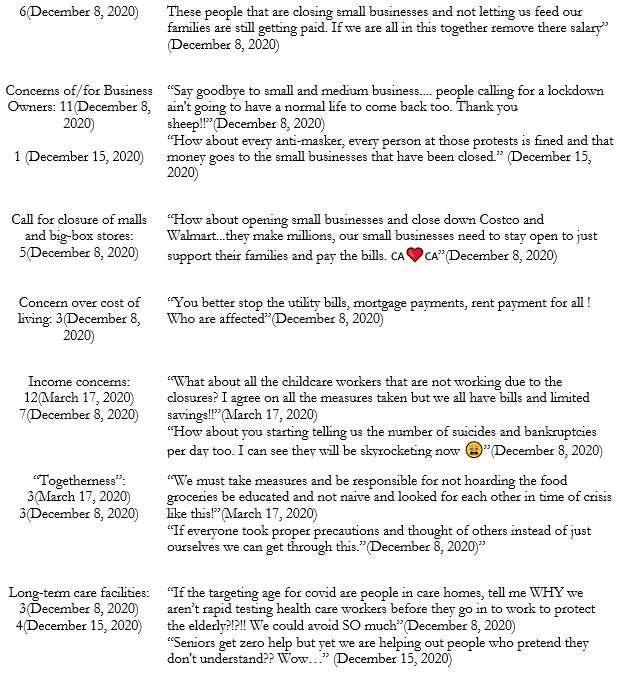
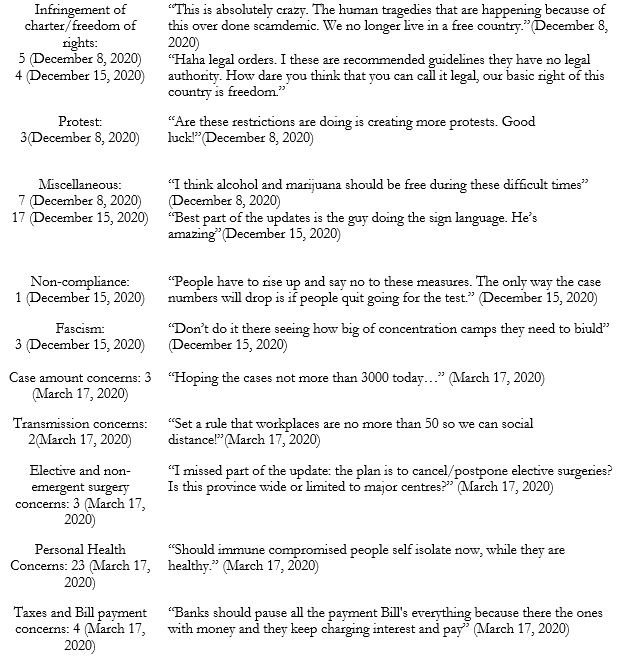

Table 6 includes examples of comments and the categories into which the “Top 100”comments were divided for 2020. In the March 17, 2020 video Many of the comments expressed concerns over the effects oflockdowns and periods of isolation on mental health and the impact of the shutdowns on smallbusinesses. Many criticisms directed towards Premier Kenney were to comment on his repeatedlateness to the “Live” announcements. Much of the criticism directed towards healthcare wasabout the ICU overload and how nurses and doctors also had to enter periods of isolation, furtherreducing the healthcare system’s capacity. Other healthcare criticisms were aimed at the closure of hospitals to the general public for non-emergent surgeries and treatments. Many individualsexpressed income concerns and demanded that Premier Kenney and other politicians take paycuts or suspend their income. The concept of “togetherness” also made headway in thecomments. The commenters encouraged others to refrain from protests and maintain properprecautions so that the situation could be remedied as soon as possible. Care homes were alsobrought up as a concern once again. Criticism of the government was largely connected toconcerns for mental health and income during the lockdown.
On the December 8, 2020 video comments in the category of conspiracy mainly related to criminal activities and training of the Chinese military as well as Covid-19 being a hoax and conspiracy about false-positive tests being made by individuals who were untested and non-Covid-19 related deaths being filed as Covid-19 fatalities. The miscellaneous comments stated politicians should have pay cuts. Several called out the potential lack of sanitation through each speaker change (placing used masks on the podium during speeches and not sanitizing the podium or microphone before usage). Comments that fell under that category of government criticism were primarily about Jason Kenney’s punctuality and lack of income support being provided for citizens.
For December 15, 2020, a large portion of the criticism in comments was directed at the governments because of their delayed response and inaction and many individuals were concerned about their source of income and cost of living. Additionally, many individuals wished for a lockdown to come sooner, stating that many other cities and continents had already implemented a similar strategy. Many individuals were concerned about the health of themselves and their familiars, stating that they wished to know more about the current numbers and the fatalities of the coronavirus. These commenters also hoped for further clarification on how restrictions affected those in camps and beauty businesses (hair and nail salons.) More than anything, individuals wanted to know more about the virus and the current restrictions being implemented. Several commenters also had concerns about border security concerning the quarantining of individuals coming from out of Canada.
Table 7
Facebook Comments: 2021
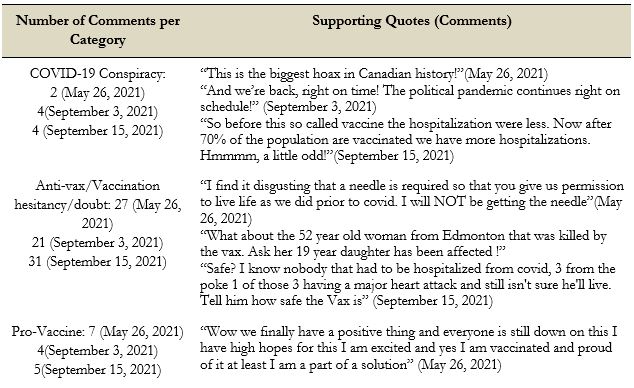
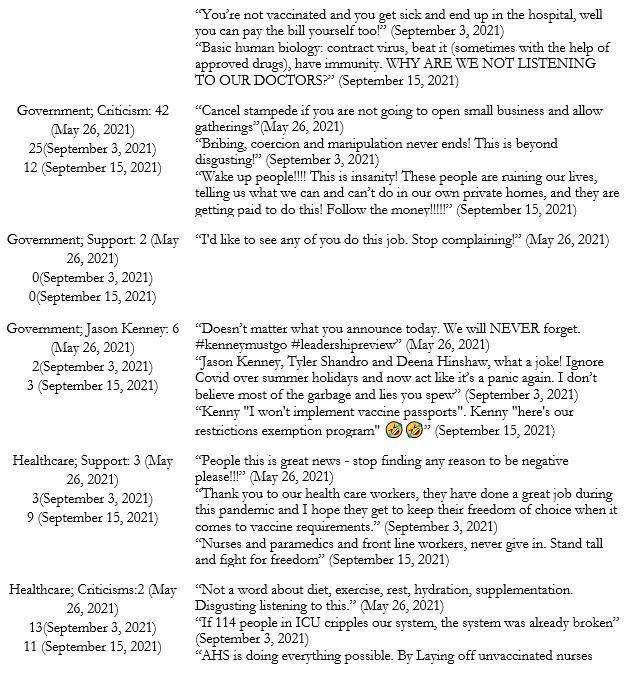

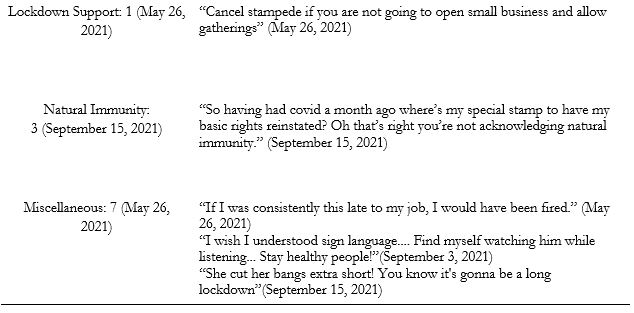
Table 7 includes examples of comments and the categories into which the “Top 100” comments were divided. On the video for May 26, 2021, the most overlap was between anti-vax/vaccine-hesitancy/doubt and the infringement of the charter/freedoms with governmental criticism. Many commenters criticized that the Calgary Stampede was allowed to proceed, but they were not allowed to have small gatherings and visit close friends or family. Criticism was targeted towards the announcement of the lottery and additional incentives. Many individuals thought that those funds would be better targeted toward the healthcare system and supporting small businesses. Other criticisms were commenters posting feelings of being manipulated and coerced into following restrictions and mandates. Most of the comments in support of healthcare are tied to comments in support of vaccination. Commenters specifically called for Jason Kenney to resign.
For the September 2, 2021 video a large portion of overlap was between Government criticism and infringement of the charter. Out of the 45 comments in criticism of the government, four specifically referred to Jason Kenney. Vaccine hesitancy and doubt also frequently overlapped with criticism of the health care system and was about relying on our borne and built immunity. “Do not comply” refers to cases in which commenters encouraged others not to mask, social distance, or follow other health care mandates, and stated that they would no longer be complying. Four comments under the category “Humanitarian concerns” contain allusions to fascism, segregation, and slavery. The one comment on religion stated that the commenter would have faith in their lord and the immunity he gave them.
In the September 15, 2021 video most comments in the category for vaccine criticism came from comparing case rates prior to vaccination and after vaccination. Many commenters felt that the vaccine was ineffective due to the increase in cases when compared to last year’s positive cases. In their eyes, the only significant change is the introduction of vaccines. Individuals that have natural immunity wished to have an exemption from the vaccine and doubted case numbers. Some commenters who owned businesses were not pleased to hear about the Restrictions Exemption Program. Many individuals called to take a stand against the implementation of further restrictions and voiced their feelings about not having a choice to become vaccinated.
Facebook Comments Data Summary
Tables 9 to 13 reiterate the same general opinions that the Facebook reactions do, mainly containing opinions portraying anger and concern. The comments found throughout the videos point toward the division of populations mentioned in the video analysis: vaccinated vs. unvaccinated, Albertans vs. the UCP, and small business owners vs. the government. Common themes in all the Covid-19 update video comments had to do with restrictions infringing on “The Canadian Charter of Rights and Freedoms,” “forced” vaccination, and criticisms towards the healthcare system and current Alberta and Canadian governments.

